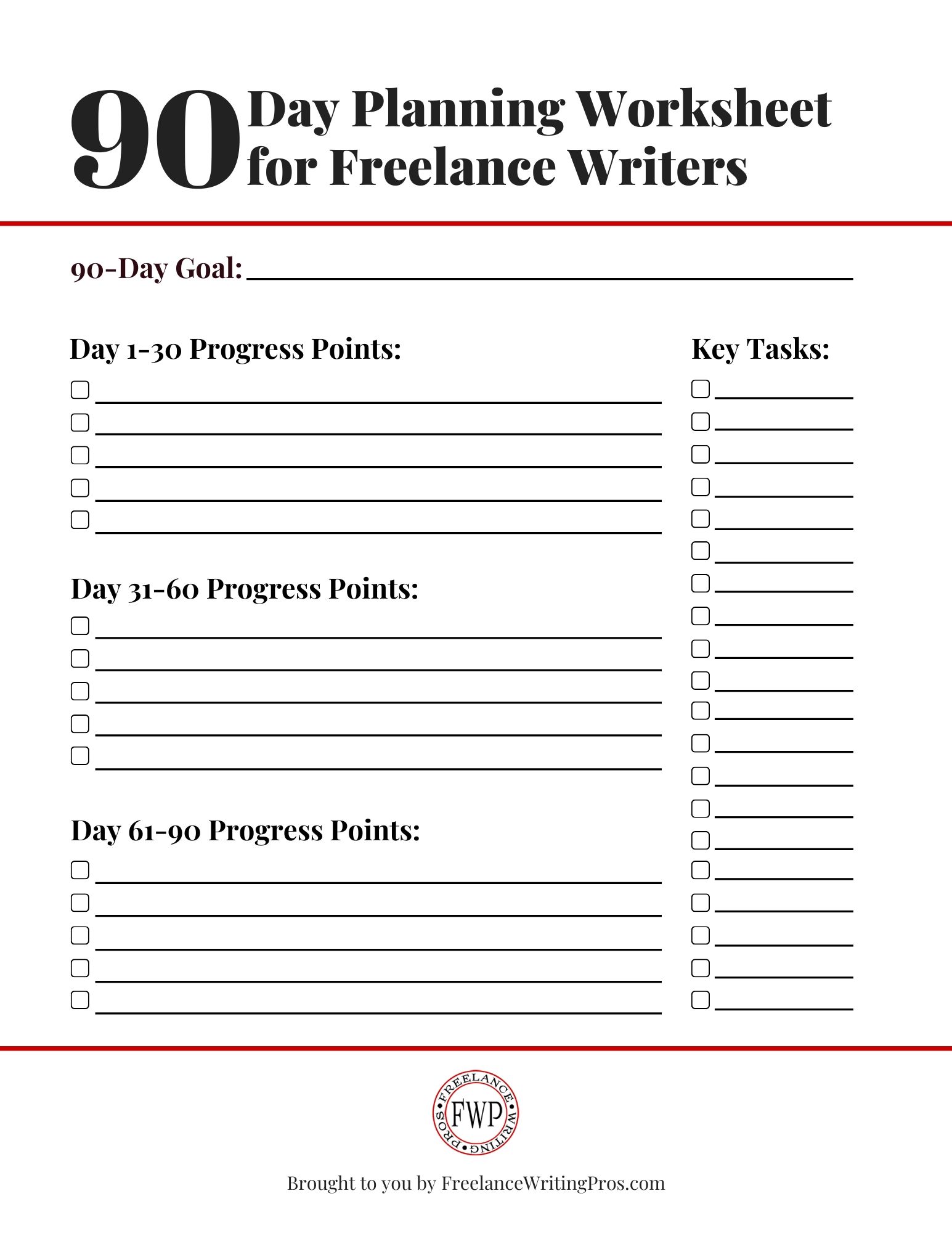
In my post “Think Like a Boss for a More Successful Freelance Writing Career” I mentioned one of my most important goal-setting tools: 90-day planning. Today let’s take a deeper dive into that strategy for setting and reaching your freelance writing goals, why 90-day sprints work so well, and how you can work up your own 90-day plans, challenges, and experiments.
A 90-day plan might be something you work out regularly, such as every quarter. But you can start one any time, for any goal. And while you might move from one 90-day planning session to the next, you can also use this strategy for standalone goal-setting and progress tracking.
Why 90-Day Planning?
Annual goals can sometimes feel unreachable early on. Or you might make great progress toward them early in the year only to lose your motivation down the line. On the other hand, monthly goals might be great for short-term progress, but that’s often not enough time to reach more significant milestones.
A 90-day plan can be a happy medium.
You can do a lot in three months that you can’t do in one. And 90-day planning can also let you break down your biggest annual goals into more workable, and more motivating, three-month blocks.
We’ll look at this example more shortly, but to put this in perspective, think about your freelance writing income.
You might have a yearly target in mind. But if you get off-track, it’s easy to get discouraged. You could set monthly goals, but again you run into the same issue. Missing your target one month can be demoralizing for some freelancers, and they might not recover the following month.
When you break up a yearly goal into 90-day planning sessions, you set yourself up to succeed.
A 90-day plan holds you accountable year-round, but there’s enough flexibility built in that you can recover. Have a slow month? You have two more to make up those earnings to reach your 90-day goal. Miss the 90-day goal by a little bit? You can adjust your goal for your next 90-day sprint to keep your yearly target on-track.
How to Create a 90-Day Plan That Works
If you think 90-day planning could be a good option for you, there are some key things to keep in mind.
For example:
- Any goal you create a 90-day plan around should be measurable.
- You should be able to break down each goal into at least three progress points or checkpoints.
- Your 90-day plan is something you need to refer back to regularly — at least weekly, and sometimes daily.
Let’s break this down a bit more.
Why Measurable Goals Matter
You’ve probably heard of SMART goals — these are goals that are specific, measurable, attainable, relevant, and time-bound.
With 90-day planning your goals are already time-bound. But whether you go with full-on SMART goals or not, at a bare minimum you’ll want them to be measurable. After all, you can’t track something that can’t be measured. And 90-day plans are all about tracking progress and taking small steps toward big goals.
Not sure what measurable goals might look like?
Here are some examples:
- Income targets
- Number of leads, new clients, or total gigs
- Increasing search engine traffic to your site
- Landing X number of new testimonials
- How many hours or days you want to work to reach your income goals
- A new product you want to release as another income stream (you might measure by a word count or page count goal, or simply measure steps toward completion)
You have a starting point, an end point, and you can track progress toward that end.
The Importance of Progress Points
In between that starting point and your end goal, there’s a path you’ll want to follow. Scheduling progress points helps you stay on that path.
For example, you wouldn’t set of goal of “10 new clients in 90 days,” land two, do nothing for 60 days, then suddenly rush for another eight new clients in the last few weeks before your goal’s deadline. You would set progress points — maybe three new clients after 30 days, seven by the 60 day mark, and your final goal of 10 new clients by the end of 90 days.
You might break that down even further.
For example, 90 days is a little over 12 weeks. So you might set week-by-week progress points instead. Perhaps your first week focuses on gathering a set number of leads, your second week is spent sending initial pitches or working on some other marketing tactic to attract freelance writing clients, and then you aim for one new client per week for the next 10 weeks.
When you break down your larger 90-day goals into bite-sized bits, you never lose sight of what you need to do next to maintain forward momentum.
Checking in with Your 90-Day Plan
It’s not enough to set a 90-day goal and come up with a general plan for getting there. You’ll want to refer back to that plan regularly — frequently.
If you’re a big planner and scheduler like I am, you’ll have long-term goals, monthly plans, and even weekly and daily to-do lists.
You would refer back to your 90-day plan when creating all of these.
Let’s go back to the previous example of wanting to land 10 new clients over 90 days. You might do a check-in:
- when you set your monthly goals and task lists;
- when you put together your weekly plans;
- when writing up your daily to-do lists.
Every level of planning should tie back to your 90-day plan.
You won’t just map out your progress points we looked at earlier. You’ll also focus on the more actionable elements so you know exactly what you need to do on every single work day to get closer to reaching your larger goals.
Options for Tracking Your 90-Day Plan
There are a number of ways you can track your 90-day plans and progress. For example, you can use a:
- traditional planner;
- bullet journal;
- to-do list or organizational app like Todoist;
- notebook or index cards (I’m personally a fan of 5″x8″ cards for the weekly lists and 4″x6″ cards for daily ones);
- 90-day planner worksheet like the one I’ve released below.
My planning is spread out across a variety of tools.
I use bullet journals for longer-term progress tracking and monthly goals and task lists. I use Todoist to break things down into all the micro-tasks that need to be scheduled. And then I use both index cards and Todoist to manage daily lists. This lets me keep a card visible on my desk at all times, while Todoist makes it easy to move things around and access task lists from any device no matter where I am.
90-Day Planning Example: Freelance Writing Income
Let’s look at a simple example that could apply to any freelance writer — an income target.
You might have a yearly income goal in mind already. Maybe you’re looking to have your first year where you gross six figures. So you set a minimum goal of earning $100k in the New Year.
Start with a Measurable 90-Day Goal
To work within a 90-day planning setup, you’d first want to choose a measurable income goal for your first 90-day cycle.
In this case, let’s keep it simple. Three months is a quarter of the year, so we’ll say you want to split up your earnings evenly. You would build your first 90-day plan around a $25k income target.
Next, Break Your 90-Day Goal Down into Progress Points
Once you have your 90-day goal, you’ll create the path you want to follow to get there. Again, to keep it simple, let’s say you want to split things up evenly. So you might set progress points of:
- $8333 by Day 30
- $16,666 by Day 60
- $25,000 by Day 90
Depending on where you’re starting, those might still feel like intimidating or overly-ambitious numbers though.
If so, maybe you would take a 12-week strategy instead and your progress points would look more like:
- $2083 by the end of Week 1
- $4166 by the end of Week 2
- $6249 by the end of Week 3
- $8332 by the end of Week 4
- $10,415 by the end of Week 5
- $12,498 by the end of Week 6…
And you would keep adding another $2083 each week until you reach that 90-day target.
You can also adjust this in other ways.
For instance, you might start more aggressively while your motivation is high. Or you might opt to ease into things and save bigger targets for later in the 90-day sprint. But the general idea remains the same — every progress point should be just as measurable as your overall goal.
My personal preference here is to always have 30-60-90 day progress points. And then I drill down deeper depending on the specific 90-day plan. This gives me a goal big enough to get excited about, but it still keeps things manageable.
Build Your Task Lists
Once you have a set of progress points to work from, you can build your task list. This would include all the specific tactics you plan to use — your to-do list.
I highly recommend only building detailed to-do lists up to your next progress point.
If you build lists around your bigger 90-day goal, and then you miss a progress point’s target, you have to adjust everything else to make up for it. That can be not only time-consuming, but discouraging.
So start with your first 30 days. Set that progress point first. Then break it down into smaller progress points if you want to. And finally create a highly-specific to-do list to get you to Point A. When you get there, do the same to get to Point B. And keep going until you reach that 30-day sub-goal.
I also highly recommend keeping those detailed to-do lists separate from your larger 90-day plan. This way you’re free to make adjustments in the small things without feeling tempted to alter your larger goal.
Other Options for 90-Day Sprints
Using 90-day planning for business goal-setting can be both effective and fun. But you can use 90-day sprints in different, though similar, ways too.
For example, you might set up either 90-day challenges or 90-day experiments.
I’m a huge 90-day planning fan. I use this method for many things, both business and personal. There are income targets both for clients and my sites. There are also traffic plans, sales plans, and all sorts of personal 90-day plans (like prepping for a house move).
But I’m also a huge fan of challenging myself. The moment I stop pushing myself is the moment I’ll know it’s time to throw in the towel on something. While I use these more in my personal life (think mile or weight loss challenges, or home projects, or learning-related challenges), you could create 90-day challenges around your business too. While these can be measurable like other goals, they don’t have to be.
Example 90-Day Challenges
- Land a byline in your dream publication.
- Send X number of pitches over 90 days (make it something significantly more than your standard pitch rate).
- Write the first draft of a new book that would be a perfect addition to your freelance writer platform.
I’m also constantly running experiments. Some are with the intention of being able to share results. And some are a way to let me test new tools or different strategies. You can do the same in your career.
Example 90-Day Experiments
- Swap a tried-and-true marketing tool for a new one and see how the results compare.
- See if you can launch a new profitable blog in a niche related to your freelance writing services.
- If you’re normally a query fan, test the query-free route (or vice versa).
- Test new web copy on your professional website (or set up A/B tests to see how it affects conversions).
- Experiment with a four-day work week and see how your productivity and income compare to a typical five-day one. (In my case, it worked out much better, and I’ve stuck with it for about 10 years now.)
Free 90-Day Planning Worksheet
Ready to jump into 90-day planning for your freelance writing business?
I’ve created a simple 90-day plan worksheet you can use to help you get started. You can preview it below or click the preview image or download link to download a copy now.

